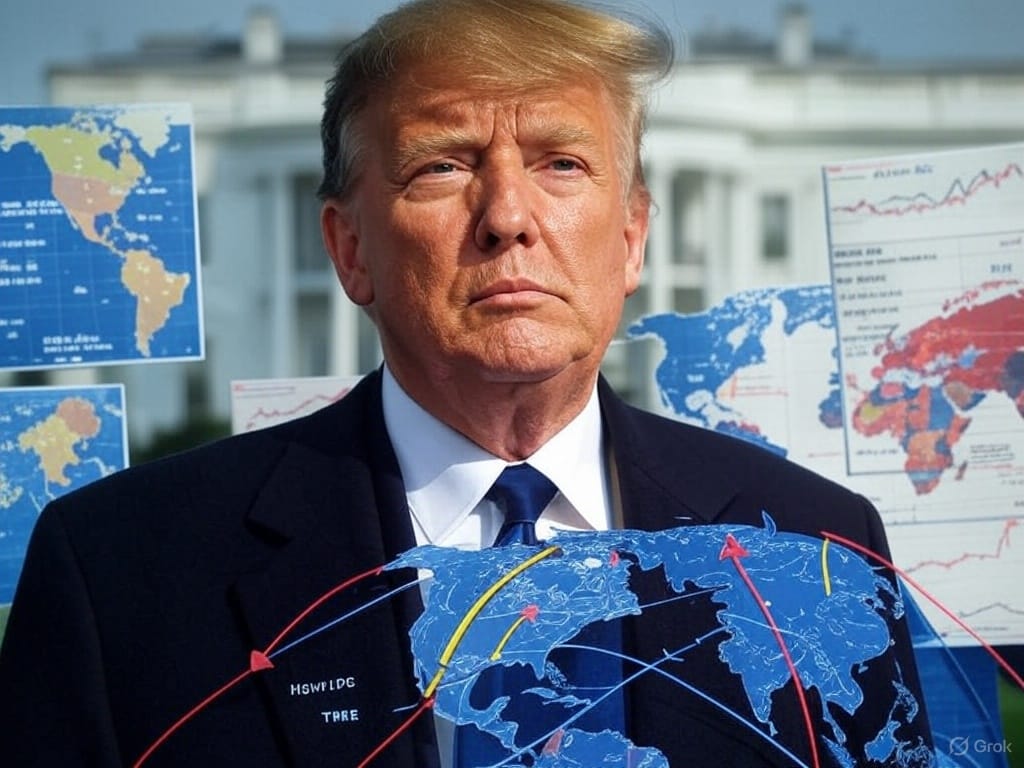Given the initiation of a worldwide tariff war under the Trump administration as of April, 2025, global trade dynamics are shifting rapidly, presenting both challenges and opportunities for companies like AUSPI, an Electronics Manufacturing Services (EMS) provider with a supply base in China, Mexico, and the Czech Republic, alongside nearshore manufacturing solutions.
This analysis explores the emerging trade trends and outlines strategies AUSPI can adopt to help its customers navigate the resulting trade conflicts effectively.

AUSPI ENTERPRISES CO., LIMITED
Room 910, 9/F.,
655 Nathan Road,
Kowloon, Hong Kong
Tel: +852 3018 6968
AUSPI ELECTRONICS (SHENZHEN) CO., LTD.
A1101 SOUTH TOWER I, TIAN'AN CYBER PARK,
N. HUANGGE RD, LONGGANG CENTRAL CITY,
SHENZHEN 518172, P.R.C.
Tel: +86 755 8931 2758
AUSPI EUROPE S.R.O.
U SMALTOVNY 716/3,
370 01 CESKE BUDEJOVICE,
CZECH REPUBLIC
Tel: +420 3819 68926
AUSPI UK LIMITED
2 Oldfield Road, Bocam Park,
Bridgend, CF35 5LJ
United Kingdom
Tel: +441656480032
AUSPI USA, LLC
9021 NOLAN CT,
PLANO, TX 75025,
USA
+1 469 998 9168
AUSPI BRASIL LTDA
R Pastor William Richard Schisler Filho,
856 – Itacorubi, Florianopolis, SC ,
88034-100, Brazil
Tel:+55 61 3686 0908
AUSPI RUS
194294, Saint Petersburg, Pargolovo
Tikhookeanskaya street, 14 k. 1 litera A,
pomeshch. 1-H office 3
Tel: +7 495 1280 328
Auspipanamerica RL de CV
Ave. Plan de Ayala 8144 Col. Lomas de Monte Carlo,
Playas de Rosarito, Baja California Norte 22705, Mexico
Tel: +52 686 633 2681
WhatsApp/Mobile: +52 664 547 9908
AUSPI Global Network
Emerging Global Trade Trends
1. Escalation of Protectionism and Regionalization
The Trump administration’s tariff policies, including a baseline 10% tariff on all imports to the U.S. and higher reciprocal tariffs on countries with significant trade surpluses (e.g., up to 54% on China), signal a return to protectionism.
This shift is likely to fragment global supply chains, pushing companies to regionalize production to mitigate tariff costs.
Countries in Southeast Asia (e.g., Vietnam, Thailand) and North America (e.g., Mexico) may see increased manufacturing investments as firms seek alternatives to China, while Europe could strengthen intra-regional trade to offset U.S. tariffs.
2. Supply Chain Diversification and Resilience
The tariff war is accelerating the “China+1” strategy, where companies diversify away from reliance on Chinese manufacturing.
However, with tariffs now targeting other Asian nations (e.g., 46% on Vietnam), businesses will prioritize resilience over cost alone, seeking multiple supply hubs to hedge against geopolitical risks.
Nearshore and onshoring options, particularly in North America and Europe, will gain traction as firms aim to reduce exposure to long-distance trade disruptions.
3. Cost Pressures and Price Volatility
Tariffs will increase the cost of goods imported into the U.S., with estimates suggesting a 2.3% rise in U.S. consumer prices and an additional $3,800 annual cost per household.
Manufacturers like AUSPI will face higher input costs, particularly from China, and may need to pass these on to customers unless mitigated through strategic sourcing or production shifts.
Currency fluctuations, such as a weakened Chinese yuan or Mexican peso, could partially offset tariff impacts but introduce further volatility.
4. Retaliatory Tariffs and Trade Blocs
In response to U.S. actions, countries like China, the European Union, and potentially others in Asia are preparing retaliatory tariffs. This tit-for-tat escalation could shrink U.S. export markets, prompting non-U.S. customers to seek suppliers outside the U.S. sphere of influence.
Trade blocs like ASEAN or the EU may deepen integration, offering tariff-free zones that contrast with the U.S.’s isolationist stance.
5. Strategic Negotiations and Exemptions
The Trump administration has hinted at using tariffs as leverage for negotiations, as seen with TSMC’s exemption after a $100 billion U.S. investment.
Companies and countries that align with U.S. interests – through investments, trade deficit reductions, or geopolitical cooperation—may secure favorable terms, creating a patchwork of trade relationships rather than a uniform global system.
Opportunities and Challenges for AUSPI
Our Opportunities:
Multi-Regional Footprint: AUSPI’s supply bases in China, Mexico, and the Czech Republic position it to pivot production across regions, aligning with customers’ needs to avoid high-tariff zones.
Nearshore Advantage: With Mexico as a nearshore option for U.S. customers, AUSPI can capitalize on the 25% tariffs already imposed on Mexico (lower than China’s 54%) and potential exemptions under the USMCA framework.
European Market Access: The Czech Republic base offers a gateway to the EU, where customers may seek alternatives to U.S.-linked suppliers amid retaliatory tariffs.
Challenges:
China Dependency: A significant portion of AUSPI’s supply chain in China faces steep tariffs, increasing costs for U.S.-bound goods unless production is shifted.
Logistical Complexity: Managing a diversified supply chain across three continents requires robust coordination to maintain efficiency and meet customer timelines.
Customer Cost Sensitivity: Clients may pressure AUSPI to absorb tariff-related cost increases, squeezing margins unless offset by value-added solutions.
AUSPI Strategies to Mitigate Trade Conflicts for Customers
1. Optimize Regional Production Allocation
AUSPI will assess each customer’s primary markets and reroute production accordingly. For U.S. customers, ramp up manufacturing in Mexico to leverage its proximity and lower tariff burden compared to China.
For EU clients, expand operations in the Czech Republic to avoid U.S.-EU tariff escalations (currently 20% on EU goods).
China-based production can focus on non-U.S. markets or serve as a low-cost hub for components where tariffs are less prohibitive.
2. Enhance Nearshore Solutions
Promote Mexico as a nearshore manufacturing hub for North American customers, emphasizing reduced shipping times, lower tariffs relative to Asia, and alignment with USMCA benefits.
AUSPI could invest in capacity expansion in Mexico to handle increased demand, positioning itself as a tariff-resilient partner.
3. Diversify Supplier Networks
Reduce reliance on China by sourcing components from Mexico, the Czech Republic, or emerging low-cost regions like Vietnam or Malaysia (despite their own tariff risks).
This diversification minimizes the impact of China’s 54% tariff on U.S. exports and prepares for potential supply chain shocks from retaliatory measures.
4. Offer Cost-Mitigation Services
Provide value-added services such as tariff analysis, supply chain redesign, and cost-sharing models. For example, AUSPI could help customers identify tariff exemptions or redesign products by using materials from lower-tariff regions, maintaining competitive pricing.
5. Strengthen Customer Collaboration
Work closely with customers to forecast tariff impacts and adjust procurement strategies. Offer flexible contracts that allow production shifts between China, Mexico, and the Czech Republic based on evolving trade policies, ensuring agility in response to new tariffs or exemptions.
6. Invest in Technology and Efficiency
Use automation and lean manufacturing to offset rising costs, particularly in high-tariff scenarios.
By improving operational efficiency, AUSPI can absorb some cost increases without fully passing them onto customers, preserving relationships and market share.
Conclusion
The worldwide tariff war initiated by Trump is reshaping global trade into a more fragmented, regionally focused system marked by cost pressures and strategic maneuvering.
AUSPI’s multi-regional presence and nearshore capabilities provide a strong foundation to help customers navigate this turbulence.
By optimizing production across China, Mexico, and the Czech Republic, diversifying suppliers, and offering tailored solutions, AUSPI can mitigate trade conflicts, reduce customer exposure to tariffs, and emerge as a trusted partner in an uncertain trade landscape.
Proactive adaptation to these trends will be key to maintaining competitiveness and supporting customers through the evolving global trade environment.







